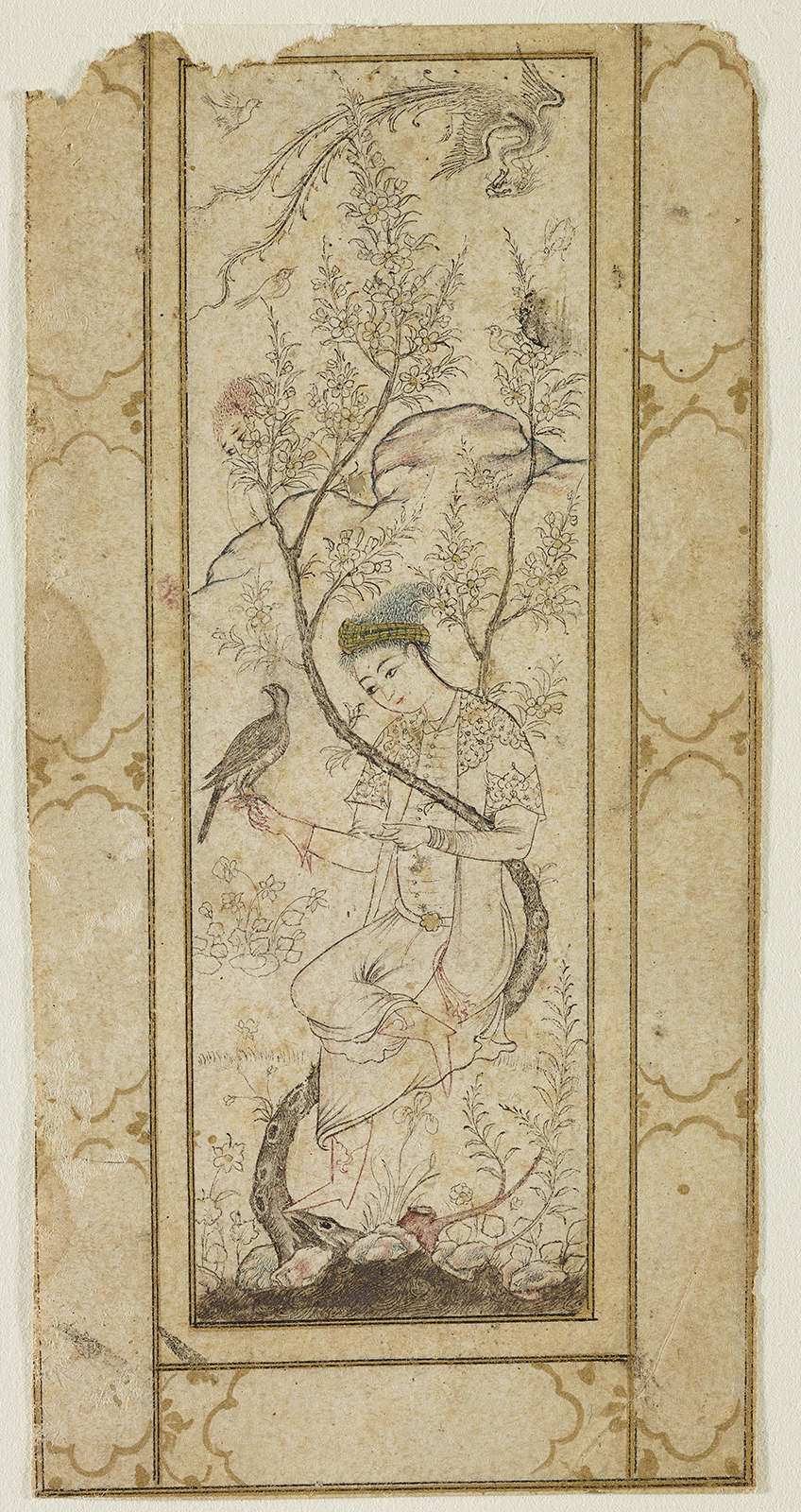Click on the image to zoom
Young Falconer
- Accession Number:AKM97
- Place:Turkey
- Dimensions:12 x 6 cm
- Date:ca. 1580
- Materials and Technique:Ink, opaque watercolour, and gold on paper
This single-page drawing of a young falconer was part of a folio detached from a slim, oblong manuscript called a safina (literally “ship” or “notebook”). Safinas mostly served as anthologies of poetry, especially in Iran. Rather than illustrate a specific poem, this drawing probably served as an analogue to the poetry.[1] Such verse was most likely of a mystical nature. The simurgh or mythical bird that soars above the young falconer in this drawing may symbolize mystical awareness.[2]
Further Reading
Hunting with a falcon in springtime is a very common motif in Islamic art, and it was a famous courtly activity among Muslim rulers and princes.[3] In wearing a conical fur hat, a coat with a decorated cloud collar, and boots, the handsome falconer in this drawing shows his affiliation with the court.
The young falconer is a fine example of a type of drawing in the style of the artist Vali Jan. In the 16th century, the Iranian style of drawing was established in Ottoman court art. Shah Quli came from Tabriz and fertilized the court of Sultan Suleyman I (1520–66) with his style, and Vali Jan came from Qazvin to join the courtly workshop of Sultan Murad III (1574–95). Vali Jan was one of the artists who painted and drew in the so-called Saz style (the depiction of stylized, serrated leaf foliage, often paired with fantastic creatures).[4] He likely arrived at the Ottoman court in the 1580s.[5] The slightly curved tree in the drawing can be traced to the Saz tradition. The falconer’s long, slim torso and small, round head follow the distinct late 16th-century Qazvin style. However, the conical fur hat he wears in this drawing differs from that style; it recalls the headgear of Sheykh Muhammad’s seated youth with parakeet, from about 1575, now in Washington.[6]
There is a comparable drawing in a safina manuscript with leather bookbinding at The Metropolitan Museum of Art, dated 1681 and 1685, in which the drawing serves as an analogue to the poetry.[7] The tree curves to the left while the falconer holds his falcon on his left hand. The simurgh is also on the left. Therefore, aside from the fact that there is no figure behind the hill, the drawing currently housed in New York is a vertical mirror of this drawing in the Aga Khan Museum Collection. Both are evidence of the long Persian tradition of creating illustrated literary anthologies and their technical development through the centuries.
— Filiz Çakır Phillip
Notes
[1] Maryam D. Ekhtiar, Priscilla P. Soucek, Sheila Canby, and Navina Najat Haidar, Masterpieces from the Department of Islamic Art in The Metropolitan Museum of Art (New York: The Metropolitan Museum of Art, 2011), 187.
[2] Anthony Welch and Stuart Cary Welch, 30.
[3] Ibid.
[4] The Metropolitan Museum of Art, New York, Acc. 57.51.26.
[5] Walter B. Denny, “Dating Ottoman Turkish Works in the Saz Style,” Muqarnas 1 (1983): 113.
[6] The Freer Gallery of Art, Washington, Acc. No. 37.23. See also Esin Atıl, The Brush of the Masters: Drawings from Iran and India (Washington, DC: The Freer Gallery of Art, 1978), 49.
[7] The Metropolitan Museum of Art, New York, Acc. 2003.121.
References
Denny, Walter B. “Dating Ottoman Turkish Works in the Saz Style.” Muqarnas 1 (1983): 103–21. https://www.jstor.org/stable/i267849
Ekhtiar, Maryam D., Priscilla P. Soucek, Sheila Canby, and Navina Najat Haidar, Masterpieces from the Department of Islamic Art in The Metropolitan Museum of Art. New York: The Metropolitan Museum of Art, 2011. ISBN: 9781588394347
Phillip, Filiz Çakır. Enchanted lines: drawings from the Aga Khan Museum collection. 2014. ISBN: 9780991992874
Steingass, F. A Comprehensive Persian-English Dictionary (reprint). Delhi: Manohar Books, 2012. ISBN:9788173046698
Swietochowski, Marie Lukens. “Drawing.” Encyclopædia Iranica 7 (1995): 537–47. ISBN: 9781568590196
Welch, Anthony, and Stuart Cary Welch. Arts of the Islamic Book: The Collection of Prince Sadruddin Aga Khan. Ithaca, NY: Cornell University Press, 1982. ISBN: 9780801498824
Note: This online resource is reviewed and updated on an ongoing basis. We are committed to improving this information and will revise and update knowledge about this object as it becomes available.


